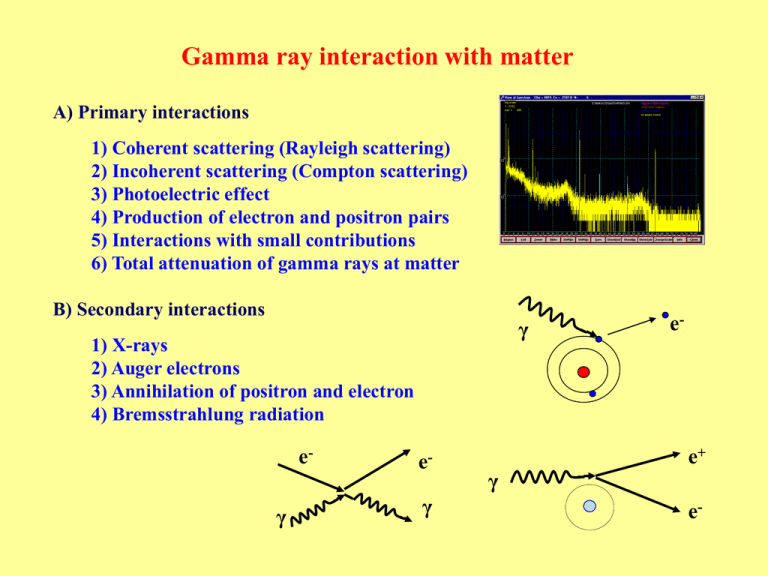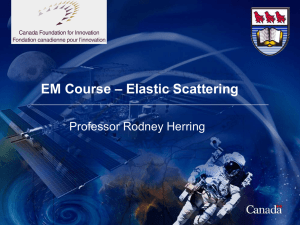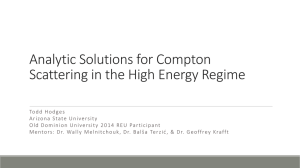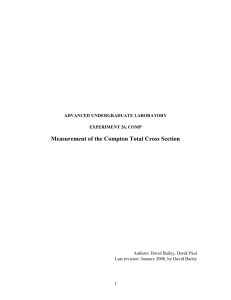Gamma ray interaction with matter
advertisement

Gamma ray interaction with matter A) Primary interactions 1) Coherent scattering (Rayleigh scattering) 2) Incoherent scattering (Compton scattering) 3) Photoelectric effect 4) Production of electron and positron pairs 5) Interactions with small contributions 6) Total attenuation of gamma rays at matter B) Secondary interactions γ 1) X-rays 2) Auger electrons 3) Annihilation of positron and electron 4) Bremsstrahlung radiation eγ eγ e- e+ γ e- Coherent scattering Coherent scattering on bounded electrons (whole atom) (energy is not transfered only direction of momentum is changed) – in the limit Rayleigh scattering R 4 0 R T 4 0 8 2 4 4 r0 T 2 2 3 02 2 0 2 02 2 0 2 02 0 R T 2 0 0 R T d R 1 2 r0 (1 cos2 ) F (q, Z ) d 2 F(q,Z) – probability of momentum transfer on Z electron atom without energy transfer r0 – classical electron radius (SI units): e2 α c r0 2,821015 m 2,82fm 2 4π 0 me c me c 2 Eγ`, ν´ Eγ, ν Eγ = Eγ´,ν = ν´ Polar graph of cross-section without inclusion of F(q,Z) influence, classical limit of Thomson scattering α = 1/137 ħc = 197 MeVfm mec2 = 0,511 MeV High energy → scattering to small angles Thomson scattering – scattering on free electrons in classical limit (coherent as well as incoherent) Polarized: Unpolarized: d TP r02 sin 2 d d T 1 2 r0 (1 cos 2 ) d 2 Θ TP 8 2 r0 T 3 T 8 2 r0 6,65 10 29 m 2 0,665 barn 3 Diffraction on crystal lattice Usage of interference during coherent scattering on layers of crystal lattice Bragg law: n·λ = 2d·sin Θ d – grid spacing λ – radiation wave length n – diffraction order Eγ [keV] 1 10 50 100 500 1000 2000 ν [EHz = 1018 Hz] 0,242 2,42 12,1 24,2 121 242 484 λ [nm] 1,24 0,124 0,025 0,0124 0,0025 0,00124 0,00062 Grid spacing is in the order of 0,1 – 1 nm Dependency of first diffraction maximum angle on X-ray and gamma ray energies for two grid spacings Spectrometers with sizes up to ten meters were built: Eγ = 1000 keV, d = 0,6 nm, r = 10 m → Θ = 0,059O, x = 10 mm Eγ = 100 keV → Θ = 0,59O , x = 100 mm Incoherent (Compton scattering) Θ Eγ, pγ=Eγ/c Eγ’, pγ’=Eγ’/c φ mec2, pe= 0 Ee , pe Ee 2 m2c2 e c2 We assumed: 1) scattering on free electron (Eγ>>Be) 2) electron is in the rest We obtain relations between energies and angles of scattering and reflection from the energy and momentum conservation laws Scattered photon energy: Where parameter: E me c 2 Reflected electron energy: Reflection angle: E E 1 1 cos 1800 E Ee E E cot 1 tan 2 E Relation between scattered photon energy Eγ and scattering angle Θ 1 2 E 1 cos 1 1 cos 1800 Ee 2 E 1 2 Diferential cross-section is described by Klein-Nishin equation (on free electrons): d C 1 2 E r0 Z E d 2 2 E E sin 2 E E We introduce energy of scattered photon: d C 1 2 1 r0 Z 2 d 2 1 1 cos 2 1 cos2 2 1 cos 1 1 cos inclusion of influence of electron binding at atom → multiplying by function S(q,Z) – probability of momentum q transfer to electron during ionization or excitation Polar graph of cross-section without inclusion of S(q,Z) influence. In the limit E → 0 we obtain graph for coherent scattering Total cross section (can be obtained by integration): 1 21 1 1 1 3 ln1 2 ln1 2 2 1 2 2 2 1 2 C 2 r02 Z Eγ > mec2 →ζ>1: C ~ Z ~ Z E Scattering of high energy electron and low energy photon – inverse Compton scattering (see exercise) Distribution of energy transferred to electrons Photoelectric effect γ Can pass only on bounded electron e- Total photon energy is transfered Electron energy: Ee = Eγ - Be Accurate calculation of photoeffect process (solution of Dirac equation) is very sophisticated: If it is enough energy (Eγ > BeK binding energy on K-shell) the photoeffect will pass almost only on these electrons 7 1 2 4 5 F 4 2Z T Cross-section (for Eγ << mec2): where and so e2 4 0c 1 137 σF = ~ Z5·Eγ-3,5 is fine structure constant near to K-shell More accurate equation for σF near to K-shell see Leo Dependency of K-shell electron binding energy on proton number Z of atom (Si – 1,8389 keV, Ge – 11.1031 keV, Pb – 88.0045 keV) σF = ~ Z4,5·Eγ-3 Production of electron and positron pairs Transformation of photon to electron and positron pair. e+ Energy and momentum conservation laws → only γ In nucleus field (mostly) Eγ > 2mec2 = 1022 keV eventually electrons Eγ > 4mec2 = 2044 keV (je 1-2Z smaller) e- Description is equivalent to description of bremsstrahlung radiation (necessity to include screening influence: predominance of pair production near nucleus – without screening): There is valid for cross-section in special cases: Without screening: 2me c E 2 Complete screening: E me c 2 Z 1 3 me c 2 Z 1 3 7 ln 2 f (Z ) 109 54 9 P 4 Z 2 r02 P 4 Z 2 r02 ln183Z 1/ 3 f (Z ) 7 9 1 54 where f(Z) is coulomb correction of order α2 2 Production in the electron field Zr0 3 42 PT 2235 („triplet“ production) Dependency of σP on Z and Eγ is: (for „lower energies“ range) σP ~ Z2ln(2Eγ) Eγ>>mec2 electrons and positrons are peaked forward Θ ≈ 1/ζ Cross-section dependency On photon energy Interaction with small contribution Nuclear Rayleigh scattering Nuclear Thomson scattering – substitutions e →Ze , me → Mj Z 2e2 Z2 1,5 1018 m and then r0 r j 2 A 4 0 M J c Total cross-sections: TJ 8 2 Z 4 Z4 36 2 r j 2 12,6 10 m 2 0,126 barn 3 A A Nuclear resonance scattering ( for example giant dipole resonance) Photonuclear reactions – resonance processes with small probability Photonuclear reactions in order of mbarn up to barn in narrow energy range interaction with electrons in order of barns up to 105 barns in broad energy range Photon interaction with coulomb field of nucleus (Delbrück scattering) – we can look on it as on virtual pair production and following annihilation Secondary processes X-ray Fluorescent efficiency (coefficient): NX NA NX NX – X-ray photons NA – Auger electrons Auger electrons Released energy is transferred during electron transition at atomic cloud on other electron Annihilation of positron and electron Positrons are stopped by ionization losses and they annihilate in the rest → 2 quanta of 511 keV (they are not fully in the rest → energy smearing of annihilation quanta) Bremsstrahlung radiation during movement of electrons and positrons Passage of electrons and positrons: 1) Ionization losses 2) Bremsstrahlung radiation elektron záření gama proton Charged particle moves in nuclear field with acceleration → it emits photons Total absorption of gamma rays at matters Photon can loss big part (even all) its energy in one interaction → beam weakens, it has not fixed range dI = -μIdx Equation for decreasing of photon number: I ex I0 μ – total absorption coefficient – inverse value of mean free path of photon at material Review of main processes σ = σF + σC + σP Total cross-sections: Multiply by number of atoms per volume unit N: N N a A where Na – Avogadro constant, A – atomic mass, ρ – material density For compound or mixture Bragg rule is valid: w1 1 w2 2 ... 1 2 Total cross-section











